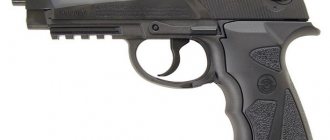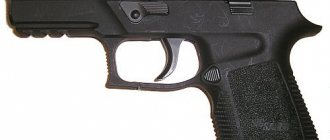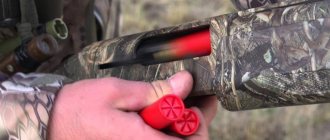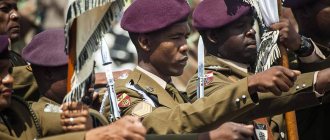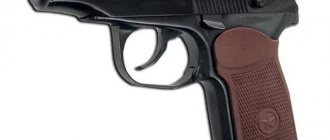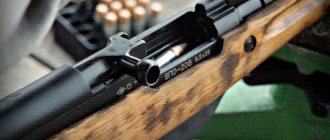If the script of some modern action movie stipulates that the hero is the owner of a powerful pistol, then the director’s choice primarily falls on the Magnum. The movie hero, the owner of the Magnum, initially has a better chance of winning than his opponent, if he has weaker weapons. Once caught in the sights of this pistol, the enemy is definitely doomed - a bullet that hits him can tear off an arm or leg. The soundtrack is reminiscent of the roar of an artillery gun. Needless to say, such a lethal variant as the Magnum stands out very impressively from the general range of cinematic weapons. The pistol is an integral part of almost every action movie. But this is a movie. As you know, it is not entirely true.
What does the word “magnum” mean?
The pistol, which is popularly called that, is truly distinguished by its enormous destructive power. But “Magnum” is not a company or a brand of weapons at all, as many people think. “Magnum” translated from Latin means “large”, “big”, and from English it is translated as “increased portion”, “non-standard dishes” (bottle or mug).
In gunsmithing, the concept “magnum” is also used to designate special cartridges, the increased powder charge of which provides their increased power.
The beginning of the “Magnum era”
The very first enhanced powder charge appeared in the 30s of the twentieth century. The creators of this high-power commercial revolver cartridge are considered to be hunter-enthusiast Elmer Keith and Colonel Daniel Wesson. The cartridge was developed by the famous arms company Winchester on the basis of the 38 Special cartridge, which until that time had been produced by Smith & Wesson. It first entered the arms market in 1934, where it received widespread approval. With the advent of this enhanced version of the cartridge, the “Magnum era” began.
Specifications
Characteristics of Magnum-44:
- manufacturer - Smith & Wesson, USA;
- years of production - from 1955 to the present day;
- type - revolver;
- trigger mechanism - double action;
- length −235, 289, 305, 350 and 407 millimeters;
- barrel - 4, 6, 6½, 8⅜ and 10 inches (102, 152, 165, 210 and 270 mm);
- weight (without cartridges) - 1220, 1332, 1460 and 1640 grams;
- magazine type - drum;
- number of cartridges - 6;
- type of cartridges - .44 Magnum, .44 Russian, .44 Special.
“Magnumization” of firearms and its downside
The first reinforced cartridges appeared in America. Later, the process of “magnumization” also affected European countries. Not only repeating rifles and rifles, but also self-loading rifles and pistols were equipped with cartridges with increased powder charges.
A revolver can more easily withstand the use of a reinforced cartridge than a pistol. "Magnum-500", as a powerful cartridge, can accelerate the wear of a structure unsuitable for such ammunition or even lead to its complete destruction. Every extra milligram of gunpowder entails an increase in the stiffness of the recoil spring. To preserve the pistol, its design requires reconstruction, including thickening the barrel, making the frame and bolt heavier. The noise that comes with shooting, the powerful recoil and the high cost of reinforced charges are not to the liking of all firearms owners. This led to attempts to independently load cartridges, significantly weakening their powder charge.
45 caliber Magnum pistol
This American firearm is intended for hunting and recreational target shooting. Center fire pistol cartridges are used for this weapon. Their cartridges are not welted and are ideal for self-loading pistols. The basis for the creation of cartridges was the 45th ACP. Their cartridges are very similar in appearance. But unlike ACP cartridges, in the 45 Magnum, due to the use of a significantly larger powder charge, the working pressure increases, which leads to thickening of the walls of the cartridge and elongation of the sleeve.
The caliber of the Magnum-45 pistol allows the use of heavier bullets and a larger powder charge than in the Magnum-44. The bullet weight is 14.9 g, the speed is 420 m/s, and the muzzle energy is 1356 J. The use of heavy bullets and an increased amount of gunpowder in the cartridges increased both lethality and recoil during shooting, the presence of which was a significant drawback of these cartridges. The increased recoil had a negative impact on aiming - the hand was thrown up strongly, and it took some time to carry out subsequent aimed shots. This problem required a solution. The way out of this situation was the technical re-equipment of all weapon structures using reinforced cartridges. During the reconstruction process, the pistols received increased weight and a handle that is comfortable to hold during recoil with both hands.
Below is a Magnum pistol. The photo allows you to appreciate its amazing appearance.
Links[edit]
- “44 Magnum Ballistic Card | Ballistics 101". www.ballistics101.com
. Archived from the original on September 16, 2022. Retrieved September 21, 2019. - Reloading Liman's Handbook
, forty-eighth edition, 2002 - ^ abc Taffin, John. (September–October 2005). ".44 Magnum: 50 years of youth!" . American pistol
. Retrieved February 16, 2007. - ^ B s d e f Frank C. Barnes, ed. Stan Skinner (2003). Cartridges of the World, 10th ed
. Krause Publications. ISBN 978-0-87349-605-6. - Barnes, Frank S.; Skinner, Steve (2003). Cartridges of the World: 10th Edition, Revised and Expanded
. Krause Publications. p. 528. ISBN 978-0-87349-605-6. - ^ abc James, Harry (June 2005). "Big 50 at .44". Weapons and ammunition
. Archived from the original on 2008-12-03. Retrieved July 7, 2007. - ↑
Hacker, Rick (July 21, 2011).
"Smith and Wesson Model 29". ShootingIllustrated.com
. Archived from the original on March 28, 2013. Retrieved December 26, 2012. - Supika, Jim; Nahas, Richard (2006). Smith & Wesson Standard Catalog: 3rd Edition
. Gun Digest Books. item 162. ISBN. 978-0-89689-293-4. - ^ab Hamm, Bill (September 28, 2004). "Ruger Blackhawk .44 Magnum 'Flattop'". GunBlast.com
. Archived from the original on January 31, 2016. Retrieved February 16, 2007. - Dougherty, Martin J., Small Arms: From the Civil War to the Present
Fall River: 2005, p. 61, ISBN 978-0-7607-6329-2 - Dougherty, Martin J., Small Arms: From the Civil War to the Present
Fall River: 2005, p. 46, ISBN 978-0-7607-6329-2 - ^ a b Pistol and revolver. 1908
- Boddington, Craig. "Fabulous .44 Mag". Weapons and ammunition
. Archived from the original on 2006-03-26. - Riebling, Terry (November 1996). "The bite from the mighty .44 Magnum". Performance Shooter
. Archived from the original on 2008-03-11. Retrieved February 21, 2008. - Taylor, Chuck (1981). The Complete Book of Combat Small Arms
. Boulder, CO: Paladin Press. p. 200. ISBN 978-0-87364-327-6. - Taffin, John. "I like solo action because..." Sixguns.com. Archived from the original on March 11, 2008. Retrieved February 21, 2008.
- "BBTI - Ballistics by Inch:: .44 Mag Results". www.ballisticsbytheinch.com
. Archived on May 2, 2010. Retrieved April 30, 2010. - ^ abc Hawks, Chuck. "Forest and Guns". Archived from the original on March 4, 2008. Retrieved February 21, 2008.
- Jamison, Rick (August 2000). "Brand New Ruger's .44 Deerfield". Shooting time
. Archived from the original on September 27, 2007. - Accurate Arms, 21.3 grain No. 9 and IMI 240 grain JHP bullet; see rifle [ dead link
] and pistol. Archived November 20, 2008, on the Wayback Machine. - TUFFIN, JOHN. "TAFFIN TESTS: .44 MAGNUM". Archived March 7, 2008. Retrieved February 21, 2008.
- Fryxell, Glen E. "SSK Bullets". Sixguns
. John Taffin. Archived from the original on May 12, 2010. Retrieved October 20, 2009. - GGG Staff (October 1997). ".44 Magnums: Accuracy problems plague Model 29". Weapons, Equipment and Play
. Archived from the original on 2008-03-11. Retrieved February 21, 2008. - ↑
PS Staff (July 1997).
"Standard Silhouette Revolvers: Anaconda vs. Redhawk". Performance Shooter
. Archived from the original on 2008-03-11. Retrieved February 21, 2008. - Ramientas, Mike. ".44 Magnum Rifles - When Revolvers Are Not Enough". Gun News Daily
. Archived from the original on September 15, 2022. Retrieved August 1, 2020. - Sweeney, Patrick. "Reloading the .44 Magnum". Pistols and ammunition
. Archived from the original on 2008-02-18. Retrieved February 21, 2008. - "Ballistics Results". Remington. Archived from the original on March 11, 2008. Retrieved February 21, 2008.
- Hawks, Chuck. "Hunting with a pistol". Archived on May 1, 2011. Retrieved February 21, 2008.
- "Dirty Harry" Archived 2021-03-08 at the Wayback Machine.
- Goldberg, Jefferey (September 6, 1993). "The deadliest gun in town." New York
: 32–34. ISSN 0028-7369.
Where is it used?
The 45-caliber Magnum is popular primarily among extreme hunters, as well as recreational target shooting enthusiasts.
It is for this category that these pistols are equipped with optical sights that allow aiming at arm's length. This became possible thanks to special optical devices with a large focal length. The reinforced charges used in these weapons are also suitable for use in self-loading hunting pistols.
Due to such features of the Magnum 45 as significant weight and loud sound of the shot, this pistol is not used at all by the military and special forces. For such security forces, the compactness of the weapon and its silent use are important.
Magnum battery manufacturer
Magnum batteries are produced at AKTECH factories in Russia (Irkutsk region) and Kazakhstan. The official website of the company, which is located at https://www.aktex.ru, contains information about all the products of this company.
Imported components are used to manufacture batteries, so the finished products are not inferior in quality to products manufactured in the European Union. For the production of batteries, only modern equipment is used, so the entire process is as automated as possible. Thanks to the use of advanced technologies, batteries of this brand have a longer period of effective operation.
Gas-cylinder version
The Magnum air pistol is represented on the arms market by the original Desert Eagle model.
This pistol is also called the “Lone Eagle”. The body of the weapon has a plastic coating. The use of durable plastic in the production of this pistol provides it with a long service life and the ability to withstand heavy loads in the area of the pistol handle and bolt frame.
The design of the pistol is implemented by the “blowback” system, when the bolt frame, after firing a shot, returns back and cocks the hammer. This has a positive effect on accuracy and speed of fire. But power and speed negatively affect the consumption of the contents of the gas cartridge, which is designed for 12 liters. After 30 shots are fired, subsequent bullets do not reach the target, but fall in the air.
The pneumatic "Magnum" ("Lone Eagle" pistol) contains solid plastic blocks at the locations of the "cheeks" for the handle, which provides a pleasant tactile sensation when using the weapon.
Wildey
The Wildey pistol, named after its creator Wildey Moore, appeared on the American market in 1980 - even a little earlier than the famous Desert Eagle. Over the next decades, the production of the pistol was stopped several times for financial reasons, and then resumed again. It is currently in production at USA Firearms Corp.
Wildey Survivor
This large and heavy weapon has gas-operated automatic operation and a rotating bolt, which is quite rare for pistols. The main cartridge for Wildey is the .475 Wildey Magnum, developed specifically for it, which accelerates a 16-gram bullet to 560 m/s and 2600 J. Modern pistols are also offered chambered for the .44 AMP cartridge from the original AutoMag pistol.
Worth got his 15 minutes of screen fame by becoming the weapon of Charles Bronson, who played the main role in the third part of the original Death Wish films.
Preparation for use
Before you start using the purchased Magnum gas cylinder (Lone Eagle pistol), it must be removed from the safety lock. To prepare the weapon, use a special screwdriver key, which is included in the equipment set. With this key you can, if necessary, unscrew the locking screw located at the bottom of the handle. This creates a hole into which a CO2 cylinder is inserted. It is completely sealed. The hole for the release of gas necessary to create air flows is formed by piercing during the installation of the locking screw in its original place. The drum must be loaded with it removed. To do this, you need to press down the lever that simulates the bolt stop and move the front of the pistol forward. Such manipulations will open access to the drum. When using a Magnum air pistol, we must not forget that this is a very powerful weapon with a destructive radius of up to 200 meters.
"Lonely Eagle": advantages and disadvantages
The pneumatic "Magnum" - a pistol equipped with a "blowback" system - compares favorably with other models of gas-cylinder weapons, both in its high shooting accuracy and power. Lead bullets, which are loaded into drums, have high speed and destructive power. The disadvantages of this model, according to reviews from owners, are the weak contrast of the rear sight and front sight, which makes aiming difficult in low light, as well as the lack of a spare drum in the kit. But this problem can be solved by purchasing an additional second drum.
Weapons for self-defense
The Magnum Ekol Firat gas pistol is a Turkish-made weapon. In the pistol market, it is considered one of the best models used as an effective means of self-defense.
Recently it has had huge demand among the civilian population of the Russian Federation. To purchase this pistol, you only had to present your passport. From July 1, 2011, these weapons, like other models of foreign-made pistols, were prohibited for sale.
The expected effect from using this model is traumatic. The Magnum Ekol Firat pistol, unlike combat pistols, is not made of weapons-grade steel. For this purpose, an inexpensive and less durable material is used, which, when the gun is dropped from a height onto a hard surface, can crack, rendering the weapon unusable.
The pistol is designed to hold 15 rounds. The effective firing range is no more than five meters. According to reviews from the owners of this model, after 7,000 shots, wear is observed in the mechanism of the trigger springs and firing pin.
AutoMag
In 1970, American Harry Sanford launched a powerful AutoMag pistol designed by engineer Max Gehr. It was intended mainly for such US-specific entertainment as hunting with short-barreled weapons.
In 1972, after producing only three thousand AutoMags, Sanford's enterprise went bankrupt, after which approximately six thousand more pistols were released in turn under the TDE, OMC, Thomas Oil Company and High Standard labels.
TDE AutoMag Model 180 chambered for .44 AMP
In 1982, this line of pistols finally disappeared from the scene, but in 2015 there was an attempt to revive the production of the monster, which in its basic version weighs approximately 1.6 kilos.
The pistol was produced for two types of cartridges: .44 AMP with a cylindrical case and .357 AMP with a bottle case. A cartridge with a nominal caliber of .44 (10.74×33 mm) accelerated a bullet weighing 15.5 grams to 450 m/s, delivering 1600 Joules.
TDE AutoMag Model 160 chambered for .357AMP
This “AutoMag” remained in history as a potential replacement for the legendary “most powerful revolver in the world” of the unforgettable “Dirty Harry” Callahan from the fourth film in the series.
Operating principle of gas pistols
Gas weapons work on the same principle as their military counterparts. The difference is that a combat pistol is designed to hit a target with a lead bullet, while a gas pistol is designed to hit a target with a special aerosol jet. For this purpose, gas pistol models are equipped with cartridges containing a powder charge and a powdery lethal substance. When a shot is fired, the powder charge burns, generating the energy necessary to eject a bullet from the bore. Gas weapons emit a crystalline powder that, when exposed to high temperatures, burns and turns into a gas cloud.

